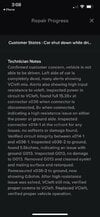Yesterday my car bricked in a parking lot when dropping off my son at work. My son put the car in park and placed the hazard lights on. I got in the driver side, and tried to change the seat position. It did not work. I noticed a new message on the screen “car unable to charge”. I had 208 miles of charge on the car. I tried to change from park to drive. It didn’t work either. I couldn’t turn off the hazard lights. When I tried to leave the car, the powered open door function would not work. I had to use the emergency override and the door would not close / latch properly afterwards. Upon inspection, the left side of the car power functions would not work. This includes the driver side doors, the driver side tail light and trunk. The other passenger side doors worked and the hood and the other lights. The tow mode function did not work either.
The tow truck company had to bungie cord the doors / strap the exterior to prevent the driver side door from flinging open. Unfortunately, the window blew out on the drive to the Tesla repair shop. I’m not going to get a diagnostic on the car until Monday. Has anyone seen this electronic failure before where the car suddenly stops working and half the car “strokes out”?


The tow truck company had to bungie cord the doors / strap the exterior to prevent the driver side door from flinging open. Unfortunately, the window blew out on the drive to the Tesla repair shop. I’m not going to get a diagnostic on the car until Monday. Has anyone seen this electronic failure before where the car suddenly stops working and half the car “strokes out”?



